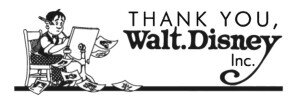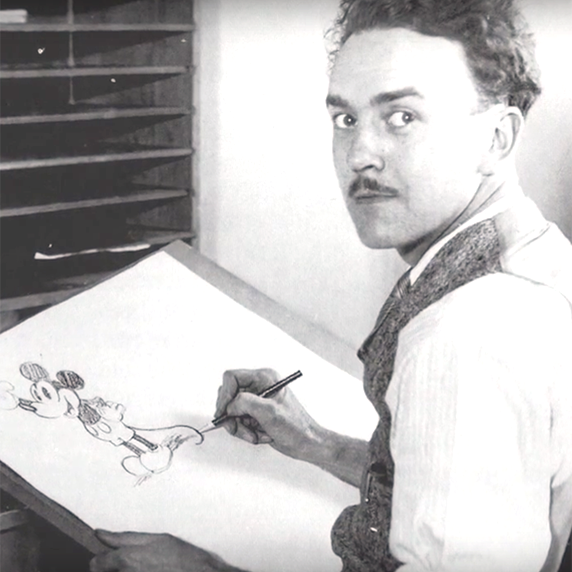History
Walt Disney founded his first professional film studio at a building designed by noted Kansas City architect, Nelle Peters, in May of 1922. He incorporated his new company with the Missouri Secretary of State’s office. He called it “Laugh-O-gram Films”.
The business operated on the second floor of the new building at 1127 East 31st Street just a block east of Troost and a couple of blocks west of the Paseo. At one point, Walt employed 11 people and occupied five rooms on the west end of the second floor of the building.
Image colorized by Christopher Dorsey
Walt had met his friend, Ub Iwerks, while working for the Pesmen-Rubin Advertising Agency shortly after Walt returned from service with the Red Cross during World War I. His brother, Roy, helped him find that job. He and Ub were laid off after the Christmas holiday rush and they briefly operated their own small ad agency before both young men were hired by Arthur Vern Cauger to work at the Kansas City Slide Company, which moved to a new location and changed its name to the Kansas City Film Ad Company. It was there that Walt and Ub first were exposed to the art and craft of making animated films. After borrowing a camera from Mr. Cauger and working in his father’s garage in the evenings,
WALT WAS CONVINCED HE KNEW HOW TO MAKE ANIMATED CARTOONS ON HIS OWN.
The work Walt Disney did at the Laugh-O-gram Studio set the pattern for his entire amazing career in film production. He made several one-reel animated cartoons there which were based loosely on classic children’s fairytales. Walt made both animated and live–action films there, including some designed to be shown in conjunction with music published by the Jenkins Music Company in Kansas City, as well as films of himself and his crew cavorting in Swope Park.
Shortly after founding Laugh-O-gram Films, Walt decided he could no longer afford the expense of keeping his apartment. He moved into the Laugh-O-gram building and it became both his home and his place of employment.
As he slept there at night, he heard mice come out looking for the crumbs from his employees’ lunches which were tossed into a wire wastebasket. He began to put out food for these mice, luring them closer to him each night.
HE SAID THAT ONE MOUSE WAS BRAVER THAN THE OTHERS
and eventually that mouse became tame and played on Walt’s drawing board while he worked. The mouse stayed in a drawer of his desk and in a small cage Walt bought for him.
The last film Walt produced at Laugh-O-gram was titled “Alice’s Cartoonland”. He recruited little four-year-old Virginia Davis, whom he had met while working for A.V. Cauger. Virginia had appeared in advertisements produced by Cauger’s company and Walt thought she would be a good candidate to portray the title character in his new series of “Alice Comedies”. Walt’s concept for these cartoons was that they would involve a little girl who would, through a variety of circumstances, go to Cartoonland and would interact as a live-action character with animated animals and an animated environment. This concept was inspired by cartoons created by the Max and Dave Fleischer’s “Out of the Inkwell” series which had a cartoon character interacting with a live-action characters and settings.
Shortly after completing that first Alice cartoon, Walt went into bankruptcy. He gave up on keeping his Kansas City studio operating after receiving no payment for the several cartoons he had produced under a contract he entered into with a church-based company in Tennessee.
Walt saved all the money he could put together to buy a first-class ticket to Los Angeles on the Atchison, Topeka & Santa Fe Railway. He left Kansas City in the late summer of 1923, taking with him the one-reel Alice cartoon in a cardboard suitcase. However, before he left Kansas City, he made a point of taking his mouse companion out into the countryside so he would not fall victim to the cats which lived in the restaurant on the first floor of the Laugh-O-gram building.
Five years later, that mouse inspired the creation of the world’s most famous fictional character, Mickey Mouse!
Laugh-O-Gram Animation Pioneers
Walt Disney is considered by many to be the greatest animation producer of all time. He got his start in animation at the Kansas City Slide Company where he met many of his future animation colleagues. He started three animation studios in Kansas City, including the Laugh-O-Gram Film Studio where he and his staff advanced their animation skills. In late summer of 1923, Walt moved to Hollywood where he and his brother Roy started the Disney Brother’s Studio, which later became the Walt Disney Studios.
Ub Iwerks and Walt Disney met at the Pesmen-Rubin ad agency in Kansas City and struck up a strong friendship. They worked together for most of their careers including Kansas City Film Ad Service, the Iwerks-Disney Studio, Laugh-O-Gram Film Studio, Disney Brother’s Studio and Walt Disney Studios. Ub provided the cartooning magic that made Disney’s Mickey Mouse character a huge success. During his short stint as an independent studio owner, Iwerks was an important contributor to many of the new animation studios in California such as M.G.M. and Screen Gems.
Hugh Harman started working with Disney as a teenager when Walt taught teen boys how to animate in return for their work on his projects. Hugh was a major contributor to the Laugh-O-Gram films. Harman teamed up with Rudy Ising to form the Arabian Nights Studio in K.C. before joining the Disney Brother’s Studio in California. After breaking with Walt, they formed the Harman-Ising Studio and became the founding animators for the Warner Brothers, Looney Tunes and M.G.M. animation labels. They also helped Hanna & Barbera get their start at M.G.M.
Rudolph "Rudy" Ising Max Maxwell moved to Kansas City from Arkansas and was attending junior college when he was hired to animate at the Laugh-O-Gram studio. He worked with Harman and Ising in their Arabian Nights studio at 31st & Troost before being hired by Disney again to work on Oswald the Lucky Rabbit for Disney Brother’s Studio. Maxwell departed with Harman and Ising to develop their Bosko and Looney Tunes cartoons. Max later became production manager for MGM cartoons.
Virginia Davis as Alice
Carl Stalling was the organ player at the Isis Theater at 31st & Troost. He created background music for Walt’s Laugh-O-Grams when screened at the Isis. Stalling helped Walt through tough times by working with Disney on a sing-along “Song-O-Reel” and by investing in his animation studio. Disney engaged Stalling in develop-ing a synchronized musical solution for his Steamboat Willie cartoon. This secured Disney’s future success and launched Stalling’s musical leadership with Disney and later with Warner Brothers. He is credited as a creator for “click track” technology still used today.
Isadore "Friz" Freleng was a year behind Hugh Harman at Westport High School where they both drew cartoons for the yearbook. Friz had worked with Hugh Harman, Ub Iwerks and Max Maxwell at Kansas City Film Ad. On their recommendation, Walt hired Freleng as an animator for Walt Disney Studios on January 15, 1927. Friz left Disney after 8 months of work in a rocky relationship. He went on though to become the premier animator for Warner brothers, creating many of their most popular characters.
Carmen "Max" Maxwell moved to Kansas City from Arkansas and was attending junior college when he was hired to Kansas City’s Animation Pioneers animate at the Laugh-O-Gram studio. He worked with Harman and Ising in their Arabian Nights studio at 31st & Troost before being hired by Disney again to work on Oswald the Lucky Rabbit for Disney Brother’s Studio. Maxwell departed with Harman and Ising to develop their Bosko and Looney Tunes cartoons. Max later became production manager for MGM cartoons.
Key Landmarks in Walt Disney’s Past
Laugh-O-Gram Film Studios
Isis Theatre
Newman Theatre
Kansas City Slide Co.
Union Station
Kansas City Film Ad Co.
Benton Elementary
Disney Home
Electric Park





















